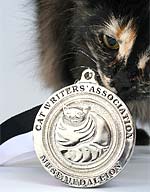 |
|||||||||||||||||||
|
|

We are the proud winners of the 2006 - 2009 winner of the Muse Medallion for Online Magazine by The Cat Writers? Association in their annual Communications Contest! (Photo courtesy of Weems Hutto).
On November 17, 2007 Felinexpress.com was honored to receive The President's Award by the Cat Writers' Association. We are very proud to have earned this distinction and will continue to provide quality information for all cat lovers.
Felinexpress.com Home > Cat Health > Salmonella - The Silent Prey |
Salmonella - The Silent Prey
A cluster of bacteria that forms within a cat’s intestinal system, Salmonella is a zoonotic agent (able to be passed from animal to human). Prevalent among humans, two factors; E. coli and Salmonella lead the way when it comes to people becoming ill after food consumption. An estimated 1.4 million cases a year are reported in the United States alone.
Salmonella is not isolated to just the United States. Salmonella also causes problems worldwide, especially in third-world countries where food preparation becomes a health hazard. The bacteria will fester within the system from 12-36 hours once it has been introduced. There are two different types (or strains) of Salmonella.
Subclinical Carrier State- the common strain is a mildly infective stage of Salmonella. A healthy cat may pick up a load of Salmonella, but because the immune system is strong, other than gastrointestinal upset, the strain is shed a few days later.
The bacteria is discarded in the waste and the saliva of the cat. According to one expert, this type of Salmonella infects thousands of cats a month in the United States alone. The owners deal with their cat fighting mild vomiting, diarrhea and poor appetite from 24-42 hours then the cat rebounds quickly. Inside/outside cats are prone to this disease because they often come in contact with spoiled or raw meat.
For the older, or the immune-deficient cat that comes in contact with these bacteria, it can easily enter the acute enterocolitis stage. The symptoms that first rear up are: fever, uncontrollable diarrhea (showing mucous or blood or the tell-tale bloody bubbles). The cat experiences mild to severe abdominal pain as the bacteria takes hold in the weakened system. Touching his belly will elicit a growl of warning to “back off because I don’t feel good!”
Following the gastrointestinal distress are loss of appetite, severe lethargy, dehydration and loss of motor function. The cat will be weak and unable or unwilling to move.
It is essential that your litter pans are well scrubbed out and scooped every time the cat uses it, because the bacteria is being shed in the feces.
Do not allow your cat to lick you while he is in this active state of the infection. Wear rubber gloves when handling the litter pans and use proper hygiene habits after handling your cat or his litter pans or food and water bowls.
Research shows that this strain of Salmonella is resistant to many of the drugs especially the antibiotics. Salmonella is still considered by many (especially raw food advocates) to be an unusual and uncommon disease in cats. However, most experts believe this underestimates the true occurrence of this disease because so many healthy cats are able to shake it off after a few days.
In order to diagnose Salmonella, the veterinarian needs too examine the fecal for bacteria, and parasites. In some cases an outside lab will assist with the bacterial cultures.
Because so many other problems stem from gastrointestinal distress, salmonella can often be overlooked in the initial analysis process. The white blood cell count is key. In Salmonella, the counts are either extremely high, or abnormally low.
The treatment is to push fluids. Keeping the food and water bowls clean is as important as keeping the litter pans scrubbed. Isolate the infected cat from the other cats in the household, so they do not become contaminated.
Bleach is an effective cleaning agent to use on an infected litter pan. Bleach should not be used for the food and water bowl cleanup, instead use hot, scalding water and antibacterial dishwashing soap. Wash the food and water bowls in a separate area other than your main kitchen or bathroom sink. After you wash the bowls out rinse them well with scalding hot water, and then pour a capful of bleach down your drain killing any lingering bacteria.
Unfortunately even with early, aggressive therapy, some cats will not respond to treatment. If the bacteria which starts in the intestinal tract is not stopped by the body's own defense mechanisms, then it will involve other organ systems by entering the bloodstream and causing the organs to shut down gradually. At this stage, all you can do is make the right decision, the hardest one, and end the cat’s suffering on the most peaceful note available.
More cat breeds |
|
? Copyright 2006-2010 Felinexpress.com, All Rights Reserved
Privacy Statement - Disclaimer - About Me


